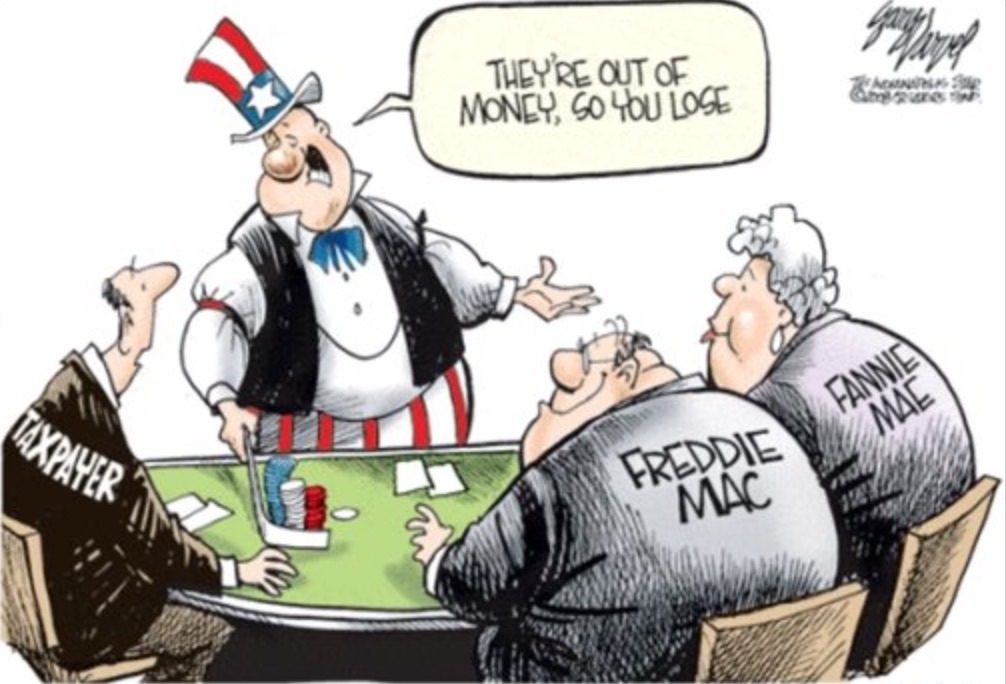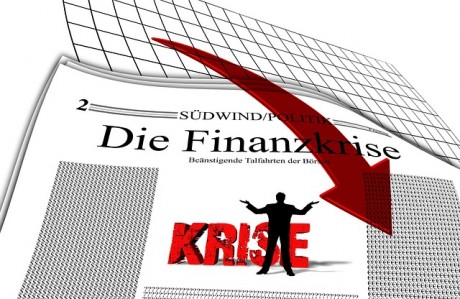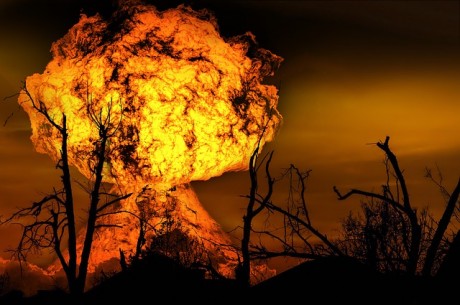The Bloomberg Commodity Index plunges to 13-year low, led by a drop in gold. http://bloom.bg/1I4NjGH
#2 Oil Is Crashing
News and views on the coming collapse
Home » Posts tagged 'financial crisis' (Page 18)
As goes the world, so goes America (according to 30 years of historical data), and so when world trade volumes drop over 2% (the biggest drop since 2009) in the last six months to the weakest since June 2014, the “US recession imminent” canary in the coalmine is drawing her last breath…
As Wolf Street’s Wolf Richter adds, this isn’t stagnation or sluggish growth. This is the steepest and longest decline in world trade since the Financial Crisis. Unless a miracle happened in June, and miracles are becoming exceedingly scarce in this sector, world trade will have experienced its first back-to-back quarterly contraction since 2009.
Both of the measures above track import and export volumes. As volumes have been skidding, new shipping capacity has been bursting on the scene in what has become a brutal fight for market share[read… Container Carriers Wage Price War to Form Global Shipping Oligopoly].
Hence pricing per unit, in US dollars, has plunged 14% since May 2014, and nearly 20% since the peak in March 2011. For the months of March, April, and May, the unit price index has hit levels not seen since mid-2009.
World trade isn’t down for just one month, or just one region. It wasn’t bad weather or an election somewhere or whatever. The swoon has now lasted five months. In addition, the CPB decorated its report with sharp downward revisions of the prior months. And it isn’t limited to just one region. The report explains:
…click on the above link to read the rest of the article…

Just in case you still harbored any doubt that absolutely zero lessons were learned from the cataclysmic financial collapse of 2008/09. We learn from the New York Times that:
AFTER the financial crisis of 2008, there was one thing that almost everyone agreed on. The government-sponsored mortgage giants, Fannie Mae and Freddie Mac, had to go. While shareholders and executives reaped the profits from Fannie and Freddie in good times, taxpayers were stuck with the bill in a crisis. President Obama described their dysfunctional business model as “Heads we win, tails you lose.” But here we are, seven years after the crisis, and nothing has changed.
In the 2008 crisis, when it looked as if Fannie and Freddie might go bankrupt, Henry M. Paulson Jr., then the Treasury secretary, argued that their fall would cause economic catastrophe. Foreign investors, stuck with their securities, would panic, and the mortgage market would shut down. So Fannie and Freddie were put into something called conservatorship, and are now government controlled, supported by a line of credit from the Treasury.
Conservatorship was supposed to be temporary — a “time out,” according to Mr. Paulson. We were going to stabilize the companies’ finances, reduce their importance to the mortgage market, and figure out a better system. But nothing happened. In fact, the situation has gotten even more precarious. In the years since the crisis, private lenders, for the most part, have been willing to make mortgages if they can immediately sell them to government agencies, mainly Fannie and Freddie. In other words, without Fannie and Freddie, there wouldn’t be much of a mortgage market.
To make things worse, the government decided to “sweep” almost all the duo’s profits into its own coffers, to be used as a slush fund for general government expenses. As Treasury Secretary Jacob J. Lew said in congressional testimony this spring, “As a practical matter it’s what has helped us reduce our overall deficit.” If there is another downturn in the real estate market and Fannie and Freddie suffer losses on their some $5 trillion in outstanding securities, taxpayers will again have to foot the bill.
Maybe we shouldn’t take our daily corporate samples too seriously. Maybe they don’t adequately represent the global economy. So IBM’s revenues last quarter plunged 13% from a year ago. It blamed China and the dollar, among other culprits. But IBM’s revenues have dropped for 13 quarters in a row. It’s a normal IBM condition and not a reflection of the global economy.
A whole slew of other tech companies chimed in with either disappointing revenues or disappointing outlooks, or both, each blaming a variety of issues, among them China and the dollar. Chip maker Qualcomm just reported a 14% plunge in its quarterly revenues. It’s having trouble in the smartphone market and will lay off a bunch of people. But maybe they’re just running into tougher competitors, rather than a lousy global economy. And the PC business, which is cratering, is dragging down all those involved. That’s structural and has little to do with the state of the global economy.
Then there’s industrial giant United Technology which reported that its revenues last quarter dropped 5%. Today Caterpillar reported that global machine sales plunged 15% in June compared to a year ago, after having dropped 12% in May and 11% in April, In Asia, machine sales plunged 19%, in Latin America 50%. And in booming North America? Down 5%, after having been up for the prior two months.
So CAT is facing Japanese, Chinese, and German competitors. It’s having to slug it out with them in China precisely when China is slowing. So it may be just CAT that’s having a hard time.
But don’t look at energy. Energy is getting clobbered….
So maybe we’re cherry-picking negative data. There are companies with actual revenue increases and positive outlooks, like Equifax, the credit bureau, which just reported a 10% jump in revenues (14% “in local currency,” as it says). Consumer borrowing is king, and Equifax expedites the process.
So what the heck is going on?
…click on the above link to read the rest of the article…
 If we were going to see a stock market crash in the United States in the fall of 2015 (to use a hypothetical example), we would expect to see commodity prices begin to crash a few months ahead of time. This is precisely what happened just before the great financial crisis of 2008, and we are watching the exact same thing happen again right now. On Wednesday, commodities got absolutely pummeled, and at this point the Bloomberg Commodity Index is down a whopping 26 percent over the past twelve months. When global economic activity slows down, demand for raw materials sinks and prices drop. So important global commodities such as copper, iron ore, aluminum, zinc, nickel, lead, tin and lumber are all considered to be key “leading indicators” that can tell us a lot about where things are heading next. And what they are telling us right now is that we are rapidly approaching a global economic meltdown.
If we were going to see a stock market crash in the United States in the fall of 2015 (to use a hypothetical example), we would expect to see commodity prices begin to crash a few months ahead of time. This is precisely what happened just before the great financial crisis of 2008, and we are watching the exact same thing happen again right now. On Wednesday, commodities got absolutely pummeled, and at this point the Bloomberg Commodity Index is down a whopping 26 percent over the past twelve months. When global economic activity slows down, demand for raw materials sinks and prices drop. So important global commodities such as copper, iron ore, aluminum, zinc, nickel, lead, tin and lumber are all considered to be key “leading indicators” that can tell us a lot about where things are heading next. And what they are telling us right now is that we are rapidly approaching a global economic meltdown.
If the global economy was actually healthy and expanding, the demand for commodities would be increasing and that would tend to drive prices up. But instead, prices continue to go down.
The Bloomberg Commodity Index just hit a brand new 13-year low. That means that global commodity prices are already lower than they were during the worst moments of the last financial crisis…
The commodities rout that’s pushed prices to a 13-year lowpulled some of the biggest mining and energy companies below levels seen during the financial crisis.
The FTSE 350 Mining Index plunged as much as 4.9 percent to the lowest since 2009 on Wednesday, with BHP Billiton Ltd. and Anglo American Plc leading declines. Gold and copper are near the lowest in at least five years, while crude oil retreated to $50 a barrel.
“This commodity bear market is like a train wreck in slow motion,” said Andy Pfaff, the chief investment officer for commodities at MitonOptimal in Cape Town. “It has a lot of momentum and doesn’t come to a sudden stop.”
…click on the above link to read the rest of the article…
 Did you know that the percentage of children in the United States that are living in poverty is actually significantly higher than it was back in 2008? When I write about an “economic collapse”, most people think of a collapse of the financial markets. And without a doubt, one is coming very shortly, but let us not neglect the long-term economic collapse that is already happening all around us. In this article, I am going to share with you a bunch of charts and statistics that show that economic conditions are already substantially worse than they were during the last financial crisis in a whole bunch of different ways. Unfortunately, in our 48 hour news cycle world, a slow and steady decline does not produce many “sexy headlines”. Those of us that are news junkies (myself included) are always looking for things that will shock us. But if you stand back and take a broader view of things, what has been happening to the U.S. economy truly is quite shocking. The following are 12 ways that the U.S. economy is already in worse shape than it was during the depths of the last recession…
Did you know that the percentage of children in the United States that are living in poverty is actually significantly higher than it was back in 2008? When I write about an “economic collapse”, most people think of a collapse of the financial markets. And without a doubt, one is coming very shortly, but let us not neglect the long-term economic collapse that is already happening all around us. In this article, I am going to share with you a bunch of charts and statistics that show that economic conditions are already substantially worse than they were during the last financial crisis in a whole bunch of different ways. Unfortunately, in our 48 hour news cycle world, a slow and steady decline does not produce many “sexy headlines”. Those of us that are news junkies (myself included) are always looking for things that will shock us. But if you stand back and take a broader view of things, what has been happening to the U.S. economy truly is quite shocking. The following are 12 ways that the U.S. economy is already in worse shape than it was during the depths of the last recession…
#1 Back in 2008, 18 percent of all Americans kids were living in poverty. This week, we learned that number has now risen to 22 percent…
There are nearly three million more children living in poverty today than during the recession, shocking new figures have revealed.
Nearly a quarter of youngsters in the US (22 percent) or around 16.1 million individuals, were classed as living below the poverty line in 2013.
This has soared from just 18 percent in 2008 – during the height of the economic crisis, the Casey Foundation’s 2015 Kids Count Data Book reported.
#2 In early 2008, the homeownership rate in the U.S. was hovering around 68 percent. Today, it has plunged below 64 percent. Incredibly, it has not been this low in more than 20 years. Just look at this chart – the homeownership rate has continued to plummet throughout Obama’s “economic recovery”…
…click on the above link to read the rest of the article…

When financial markets crash, they do not do so in a vacuum. There are always patterns, signs and indicators that tell us that something is about to happen. In this article, I am going to share with you four patterns that are happening right now that also happened just prior to the great financial crisis of 2008. These four signs are very strong evidence that a deflationary financial collapse is right around the corner. Instead of the hyperinflationary crisis that so many have warned about, what we are about to experience is a collapse in asset prices, a massive credit crunch and a brief period of absolutely crippling deflation. The response by national governments and global central banks to this horrific financial crisis will cause tremendous inflation down the road, but that comes later. What comes first is a crisis that will initially look a lot like 2008, but will ultimately prove to be much worse. The following are 4 things that are happening right now that indicate that a deflationary financial collapse is imminent…
#1 Commodities Are Crashing
In mid-2008, just before the U.S. stock market crashed in the fall, commodities started crashing hard. Well, now it is happening again. In fact, the Bloomberg Commodity Index just hit a 13 year low, which means that it is already lower than it was at any point during the last financial crisis…
The Bloomberg Commodity Index plunges to 13-year low, led by a drop in gold. http://bloom.bg/1I4NjGH
#2 Oil Is Crashing
On Monday, the price of oil dipped back below $50 a barrel. This has surprised many analysts, because a lot of them thought that the price of oil would start to rebound by now.
…click on the above link to read the rest of the article…
The office vacancy rate in downtown Calgary, the epicenter of the Canadian oil bust, could hit the vertigo-inducing level of 17.5% by the end of 2018, a new report by commercial real-estate firm Colliers International warned – and added some ominous clouds: “Given the current global macro environment, this may even be an optimistic forecast.”
While real estate is supposedly local, it’s not. It has been, like so many things, globalized. Colliers:
The geopolitical turmoil in China, Greece, and Iran must be taken into consideration, as the global instability is already affecting local top-level decisions and investor sentiment.
The biggest problems are cropping up in the sublease sector, according to the Calgary Herald, citing Colliers’ report. Sublease availability began to balloon in late 2014. The oil bust was hitting hard. Canada’s tar-sands operations are particularly at risk since they’re the world’s high-cost producers; they’re sitting ducks in an oversupplied market where an all-out fight over market share has broken out.
So, according to the report, “international energy companies began reallocating capital to other parts of the world.” Local operators, to stay alive a little longer, tried to slash operating expenses and conserve cash where they could. Layoffs and consolidations followed. A lot of people in the oil business are contractors; and their hours were getting cut. And companies began shedding by then useless office space.
But there have been few takers.
By the end of June, available sublease office space in downtown Calgary, after soaring for three quarters in a row, hit an all-time record of 2.6 million square feet. At 52% of all available office lease space, sublease space exceeded headlease space for the first time since Q4 2009, during the Financial Crisis. That’s a bad sign.
…click on the above link to read the rest of the article…
 A global stock market crash has begun. European stocks are crashing, Chinese stocksare crashing, and commodities are crashing. And guess what? All of those things happened before U.S. stocks crashed in the fall of 2008 too. In so many ways, it seems like we are watching a replay of the financial crisis of 2008, but this time around the world is in far worse shape financially. Global debt levels are at an all-time high, the 75 trillion dollar global shadow banking system could implode at any time, and there are hundreds of trillions of dollars in derivatives that threaten to wipe out major banks all over the planet. The last major worldwide financial crash was almost seven years ago, and very little has been done since that time to prepare for the next one. If global markets do not calm down, we could see carnage in the months ahead that is absolutely unprecedented.
A global stock market crash has begun. European stocks are crashing, Chinese stocksare crashing, and commodities are crashing. And guess what? All of those things happened before U.S. stocks crashed in the fall of 2008 too. In so many ways, it seems like we are watching a replay of the financial crisis of 2008, but this time around the world is in far worse shape financially. Global debt levels are at an all-time high, the 75 trillion dollar global shadow banking system could implode at any time, and there are hundreds of trillions of dollars in derivatives that threaten to wipe out major banks all over the planet. The last major worldwide financial crash was almost seven years ago, and very little has been done since that time to prepare for the next one. If global markets do not calm down, we could see carnage in the months ahead that is absolutely unprecedented.
For months, European authorities have been promising us that a “Grexit” is already “priced in” to the markets and that any “contagion” from the Greek crisis will be “contained”. Of course everyone knew that was just a smokescreen. Just in the past couple of days since the Greek “no” vote, European stocks have already been crashing. The following comes from Zero Hedge…
Does this look contained to you?
Portugal, Spain, and Italy all collapsing…
As I mentioned at the top of this article, European stocks started crashing well before U.S. stocks started crashing during the last financial crisis. If you doubt this, just look at this chart, and this chart and this chart.
Will the same thing happen again this time?
And just like I have warned repeatedly, European bond yields have started to soar. When bond yields go up, bond prices go down, so many bond investors are losing a tremendous amount of money right now. Here is more from Zero Hedge…
…click on the above link to read the rest of the article…
This post uses data from the inter area oil movement section of the BP Statistical Review published in June 2015. It is a continuation of an earlier post on Asian oil consumption and production
Total global oil trade steadily increased by 4.7% pa up to the US recession year of 2007, stagnated through the financial crisis but resumed growth in 2010, albeit at a much lower rate of 1.4% pa. In 2014, growth was only 0.5% while the volume of trade reached a record high of 56.7 mb/d.
Fig 1: Global oil trade and Asian oil imports
22.9 mb/d (40% of the global total) were imports into Asia, a whopping 9.6 mb/d up from 13.4 mb/d (30%) in 2001. That is +740 kb/d pa. Where did this oil come from?
Fig 2: Asian oil imports as part of global oil trade
Out of these 22.9 mb/d of Asian imports some 15.1 mb/d or 66% came from the Middle East, making Asia absolutely vulnerable to what is happening there.
Fig3: Asia oil imports time series
After the financial crisis in 2009 Asia’s total imports increased by an average of 4.7% pa (2014: 3.4%) while imports from the Middle East increased by only 2% (2014: 1%). This means that Asia has diversified its imports into West Africa, the Former Soviet Union, South & Central America and others. The share of the Middle East of total imports has therefore decreased from 73% in 2010 to 66% in 2014.
…click on the above link to read the rest of the article…
“The problem with the post-2007 world is that we are not in a cyclical recovery; we are in a structural depression defined as a sustained period of below-trend growth with no end in sight. The U.S. has caught the Japanese disease. Structural depressions are not amenable to monetary solutions, they require structural solutions.”
–James Rickards
Can anyone stabilize this bitch? At daybreak, anyway, the Federal Reserve governors were all bagging Z’s in their trundle beds. Maybe after a few pumpkin lattes they’ll jump in and tell their trading shills to BTFD. The soma-like perma-trance among those who follow markets and money matters appears to be ending abruptly with the recognition that sometimes robots and humans alike run shrieking to the exit. A pity when they get to the door and discover it opens onto a cliff-edge. Look out below.
All this trouble with money comes from one meta problem: aggregate industrial growth has ended. It has stopped more in some parts of the world than others, while in the USA it has actually been contracting. The cause is simple: the end of cheap energy, oil in particular. At over $70-a-barrel the price kills economies; under $70-a-barrel the price kills oil production. The bottom line is that, in the broadest sense, the world can no longer count on getting more stuff, except waste, garbage, political unrest, and the other various effects of entropy. From now on, there is only less of everything for a global population that has not stopped growing. The folks on-board are still having sex, of course, which has a certain byproduct.
This dynamic was plain to see a decade ago, but the people who run finance and governments thought it would be a good idea to maintain the appearance of growth via the usufruct mechanisms of central banking: ZIRP, QE, market intervention, and universal accounting fraud.
…click on the above link to read the rest of the article…
 As we enter the second half of 2015, financial panic has gripped most of the globe. Stock prices are crashing in China, in Europe and in the United States. Greece is on the verge of a historic default, and now Puerto Rico and Ukraine are both threatening to default on their debts if they do not receive concessions from their creditors. Not since the financial crisis of 2008 has so much financial chaos been unleashed all at once. Could it be possible that the great financial crisis of 2015 has begun? The following are 16 facts about the tremendous financial devastation that is happening all over the world right now…
As we enter the second half of 2015, financial panic has gripped most of the globe. Stock prices are crashing in China, in Europe and in the United States. Greece is on the verge of a historic default, and now Puerto Rico and Ukraine are both threatening to default on their debts if they do not receive concessions from their creditors. Not since the financial crisis of 2008 has so much financial chaos been unleashed all at once. Could it be possible that the great financial crisis of 2015 has begun? The following are 16 facts about the tremendous financial devastation that is happening all over the world right now…
1. On Monday, the Dow fell by 350 points. That was the biggest one day decline that we have seen in two years.
2. In Europe, stocks got absolutely smashed. Germany’s DAX index dropped 3.6 percent, and France’s CAC 40 was down 3.7 percent.
3. After Greece, Italy is considered to be the most financially troubled nation in the eurozone, and on Monday Italian stocks were down more than 5 percent.
4. Greek stocks were down an astounding 18 percent on Monday.
5. As the week began, we witnessed the largest one day increase in European bond spreads that we have seen in seven years.
6. Chinese stocks have already met the official definition of being in a “bear market” – the Shanghai Composite is already down more than 20 percent from the high earlier this year.
7. Overall, this Chinese stock market crash is the worst that we have witnessed in 19 years.
8. On Monday, Standard & Poor’s slashed Greece’s credit rating once again and publicly stated that it believes that Greece now has a 50 percent chance of leaving the euro.
9. On Tuesday, Greece is scheduled to make a 1.6 billion euro loan repayment. One Greek official has already stated that this is not going to happen.
…click on the above link to read the rest of the article…
 Are we about to witness trillions of dollars of “paper wealth” vaporize into thin air? During the next financial crisis, a lot of “wealthy” investors are going to be in for a very rude awakening. The truth is that securities are only worth what someone else is willing to pay for them, and that is why liquidity is so important. Back on April 17th, I published an article entitled “The Global Liquidity Squeeze Has Begun“, but it didn’t get nearly as much attention as many of my other articles do. But now that the liquidity crisis is intensifying, hopefully people will start to grasp the implications of what is happening. The 76 trillion dollar global bond bubble is threatening to implode, and if it does, the amount of “paper wealth” that could potentially be lost during the months ahead is almost unimaginable.
Are we about to witness trillions of dollars of “paper wealth” vaporize into thin air? During the next financial crisis, a lot of “wealthy” investors are going to be in for a very rude awakening. The truth is that securities are only worth what someone else is willing to pay for them, and that is why liquidity is so important. Back on April 17th, I published an article entitled “The Global Liquidity Squeeze Has Begun“, but it didn’t get nearly as much attention as many of my other articles do. But now that the liquidity crisis is intensifying, hopefully people will start to grasp the implications of what is happening. The 76 trillion dollar global bond bubble is threatening to implode, and if it does, the amount of “paper wealth” that could potentially be lost during the months ahead is almost unimaginable.
For those that do not consider the emerging liquidity crisis to be important, I would suggest that they check out what the financial experts are saying. For instance, the following comes from a recent Bloomberg report…
There are three things that matter in the bond market these days: liquidity, liquidity and liquidity.
How — or whether — investors can trade without having prices move against them has become a major worry as bonds globally tanked in the past few months. As a result, liquidity, or the lack of it, is skewing markets in new and surprising ways.
Things have already gotten so bad that Zero Hedge says that some fund managers “are starting to panic” about the lack of liquidity in the marketplace…
Fund managers who together control trillions in assets are starting to panic in the face of an acute bond market liquidity shortage.
…click on the above link to read the rest of the article…
It’s not some wayward doom-and-gloomer who said it, but the Economic Research arm of Natixis, the investment bank of France’s second largest megabank, Groupe BPCE.
The analysis was talking about the Bank of England. But the Fed and other central banks, with their ingenious monetary policies, have created similar scenarios where only the nuances are different. And now these “triggers for the next Financial Crisis” are cluttering the future, enough to where an investment bank, an entity that has tremendously benefited from these monetary policies, is beginning to fret.
“We are concerned about the UK economy,” Natixis starts out, though the UK economy is currently the shining model in Europe, where a tsunami of money and government coddling of banks appear to have solved all problems.
The analysis goes through its logic step by relentless step. Since the Financial Crisis and the deep recession it brought to the UK, growth has largely been powered by the inflation of asset prices.
UK household demand “reacts strongly to changes in property wealth,” the report said. So soaring home prices entail a sharp rise in consumption, a phenomenon that appeared in 2003, then 2006, and most recently in 2013. This is followed by a tidal wave of home buying, which started in 2004 (three years before the Financial Crisis) and once again in 2013. It’s followed by a similar tidal wave of housing starts. All of which give a strong boost to economic growth.
That “wealth effect” for property-owning households is paralleled by similar effects on the corporate side. Soaring commercial real estate prices and skyrocketing share prices “helped kick-start corporate investment” from 2005 to 2008 – just before the Financial Crisis – and once again after 2010, when commercial property prices and share prices were re-soaring. Natixis:
It is clear that the expansionary monetary policy pushed up asset prices from 2002 to 2007, from 2010 and especially 2013.
So what’s the outlook? More of the same.
…click on the above link to read the rest of the article…
With another financial crisis fast approaching the cause of the ‘08 crash hasn’t been settled. Austrians generally line up on the side of the all-powerful Fed having lowering interest rates below what the market would produce, sending capital into malinvestments: In this case, too many subdivisions of houses and other real estate. When the Fed hit the brakes in ‘06, raising its fed funds rate, housing peaked and the party was brought to an abrupt and painful end as the value of mortgage backed securities melted down.
I’ve given this talk plenty of times, most recently for The Nassau Institute in the Bahamas.
 The visual of fed funds combined with Las Vegas land and housing prices on top of a busted subdivision aerial photo is worth a thousand words.
The visual of fed funds combined with Las Vegas land and housing prices on top of a busted subdivision aerial photo is worth a thousand words.
There is another part of the story touted by Austrians such as Tom Woods and Tom DiLorenzo that government required banks to provide mortgages to those who couldn’t afford them through the force of the Community Reinvestment Act (CRA). Predictably, these borrowers couldn’t or wouldn’t pay and their mortgages turned into toxic paper that led to Wall Street’s almost demise.
Because of my experience in the non-bailed-out part of the banking sector, I’ve always doubted the CRA-did-it thesis. CRA seemed easy for the little bank I worked for as we made a number of development and construction loans for entry-level housing and even received credit for a loan made on a building where X-rated movies and sex toys were sold. These loans were made for economic reasons with no thought to CRA.
But Peter Wallison’s book Hidden In Plain Sight has changed my mind. Wallison is no tin foil hat wearer, being the Arthur F. Burns Fellow at the American Enterprise Institute and serving as a member of the 2010 Financial Crisis Inquiry Commission (FCIC).
…click on the above link to read the rest of the article…
This is what two unnamed container shipping executives, one from an Asian carrier, the other from a European carrier, told the Wall Street Journal about the containerized-freight fiasco on the China-Europe route:
“We are now shipping at an absolute loss. With the bunker-adjustment-factor surcharge at $300 for Asia-Europe, we are losing more than $50 per box.”
“Unless by a miracle demand grows, we are up for heavy losses in the next quarter and maybe the rest of 2015.”
The rate for shipping a container on that route, after plunging for months, is now below even the cost of fuel.
The China Containerized Freight Index (CCFI), which covers spot market rates and contractual rates from Chinese ports to major destinations around the world, dropped another 1.2% last week, to a multi-year low of 851.4. The China-Europe component dropped 2.5%. The CCFI is now 21% below where it was in February, and 15% below where it was in 1998, when it was set at 1,000!
The Shanghai Containerized Freight Index (SCFI) paints an even drearier scenario. Unlike the CCFI, it is composed only of spot rates, not contractual rates, from Shanghai to the rest of the world. And this babe plunged 6.8% last week to 581.25, an all-time low, 42% below where it was during the Financial Crisis, on October 16, 2009, when it was set at 1,000, and down 47% from February.
This is what the four-month plunge looks like:
The Shanghai-Rotterdam sub-index plunged 14.4% last week to an all-time low of $243 per twenty-foot equivalent unit (TEU). Rates began to collapse in February. By April, when they’d crashed to around $400 per TEU, Drewry Maritime Researchestimated that the break-even rate for most carriers was $800 per TEU on that route. But now, the rates, at $243 per TEU, don’t even cover the cost of fuel of about $300 per TEU. Hence the screaming by the shipping execs!
…click on the above link to read the rest of the article…